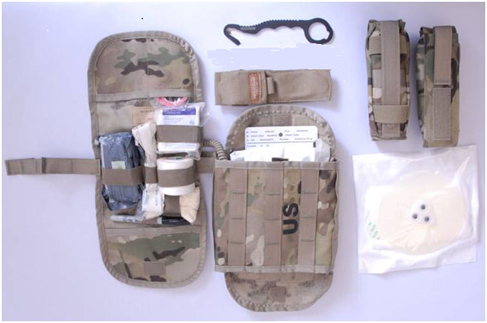Soldier Feedback Helps Improve First Aid Kit and Save More Lives

The U.S. Army Medical Materiel Development Activity worked with the Program Executive Office Soldier to develop a more compact and better equipped first aid kit in direct response to Soldier feedback.
The military issues a first aid kit to every Soldier to administer immediate self and buddy aid, as needed. Suffering a higher number of injuries during operations carried out on foot, deployed Soldiers requested that the kit include a second tourniquet. They also asked that developers modify the bag to be less cumbersome. According to Jaime Lee, product manager with the USAMMDA Medical Support Systems Project Management Office at Fort Detrick, Md, the original bag would catch on vehicle latches and impede rapid evacuation from vehicles under attack.
MSS PMO and the Directorate of Combat and Doctrine Development assisted the PEO Soldier, Soldier Clothing and Individual Equipment Project Management Office to develop and test a second generation, individual first aid kit, known as IFAK II. Developers designed the kit to weigh one pound and contain expendable medical items, including the sought after second combat application tourniquet.
The contents of the kit are packaged inside a U.S. Army Soldier Systems Center-produced, compact, yet expandable Generation II bag that attaches to a Soldier's tactical vest. The tourniquets, recognized as a lifesaver for wounded warriors, are stored in pouches that attach to the kit bag. The development team designed the pouches so that Soldiers could easily attach them to their tactical vest or store them in pants pockets, further reducing the size of the kit bag.
The IFAK II also includes a chest seal and eye shield. The chest seal can stop bleeding from a chest wound with a possible collapsed lung, allowing air into the lungs. The eye shield protects the eye from pressure caused by bandaging.
"The IFAK II can increase Soldier survivability by mitigating two leading causes of death on the battlefield, severe bleeding and inadequate airway," said Lee.
To enhance the overall functionality of the kit, designers added a Tactical Combat Casualty Care card, Sharpie pen and strap cutter.
National Institute for the Severely Handicapped employees assemble the kits. PEO Soldier SCIE PMO has been overseeing the program since 2007. The second generation kits are still in production, and fielding continues with 1,951,692 kits issued from fiscal years 2004-2013. The Defense Medical Materiel Program Office is coordinating transition of the IFAK with the joint services to Joint IFAK, known as JFAK, as a CORE program.














